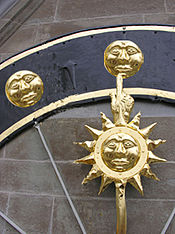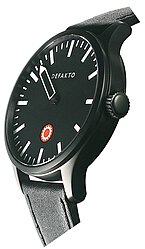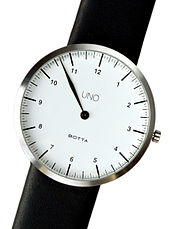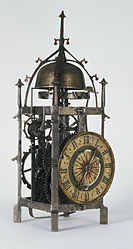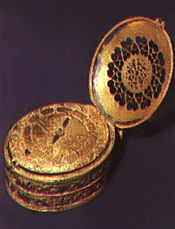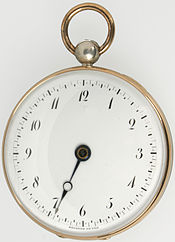One-hand watch
A one-hand watch is a watch with only one hand , namely the hour hand .

The first wheel clocks , mostly used as tower clocks, were only equipped with an hour hand for technical reasons. Clocks such as the one-hand clock, which do without components that have become familiar in the meantime, such as second hands, minute hands or dial elements, are also known as minimal clocks .
history
Until the invention of the wheel clock , the most precise measurement of the hours of the day was done using the sundial . It was not until the invention of the mechanical clock that sunshine-independent time reading was made possible. The mechanical clock - also known as the hour clock - was relatively imprecise for a long time and had to be adjusted as daily as possible using the sundial, which has now been perfected. It was not until the end of the 17th century that it was accurate enough to be supplemented by the higher-resolution minute hand. Some old one-hand clocks - most noticeable on towers - still exist today (see illustration above).
In the 1990s, modern single-hand watches appeared, mainly as wristwatches. The German industrial designer Klaus Botta is the pioneer of these watches . As early as 1986, Botta developed the first modern wristwatch based on the one-hand principle with his model UNO. The one-hand design is inspired by the structure of the sundial and follows the idea of “countering the dictation of the minute hand with the idea of decelerating ”.
Dial subdivisions
Old wheel clocks
The subdivisions of the dials of the old clocks became finer as their accuracy grew. First the dial was divided into hours, later into half and finally into quarters.
Wrist watches
Some one-pointer watches have dispensed with a dial scale (see below: first picture), but mostly a division is made at least in quarter of an hour. It is discussed whether a division down to five minutes contradicts the idea of slowing down . In one case, a hand running at double speed (6-hour clock, last picture) was used as a basis to improve reading accuracy. In contrast, there are single-hand clocks running at half speed (24-hour clocks, see third picture). Since single-hand watches do not show whether they have stopped because of the missing second hand, some manufacturers have added a signal generated by the second or minute wave ("rate indication") (see below: first picture).
Designs
Table clocks
The first wheel clocks emerged in the 13th or 14th century and were probably table or console clocks. As with the later tower clocks, its individual parts were mainly made of forged iron.
Tower clocks
The first tower clocks were one-hand clocks. Beat clocks automatically took the time from a large wheel clock and first struck the hours on bells, later also the half-hour and finally the quarter-hour. Prior to the development of the strike clock, the tower bells were struck manually by "towers" after reading the time from a small one-pointer wheel clock.
Pocket watches
The oldest representation of a watch that can be worn on the body can be found in the painting Der Kaufmann Georg Gisze by Hans Holbein (around 1530). The first pocket watches were so-called can watches , of which smaller copies were later also worn around the neck. The invention was long attributed to Peter Henlein from Nuremberg ( Nürnberger Ei ) (around 1504/1509). Today, however, research tends to assume a longer lasting development that took place in southern Germany, France and Italy.
Portability is an aggravating requirement for the construction of an accurate clock. Pocket watches therefore received the minute hand later than the grandfather clock.
The shape of the pocket watch changed from the oval box to the round disc, the shape still common today. The pocket watch also had the function of an item of jewelery, which is why many other shapes, such as crosses, shells and stars, but occasionally also skulls, appeared at the beginning.
Wooden watches
In the beginning, wheel clocks were expensive and therefore reserved for the nobility and bourgeoisie . The poorer rural population only came into possession of a clock with the development of cheaper wooden clocks. Wood was cheaper than iron and easier to work with. The serial production settled in the Alpine region , in the Swiss Jura and in the Black Forest . Production took place mainly in winter, which was long there and the work in agriculture was interrupted for a long time. In the Black Forest were Wooden Clocks built in the 18th century.
Wooden clocks were only equipped with a minute hand later than the expensive metal clocks.
Miniaturized one-hand wooden wheel clock, Paul Gerber (Zurich / CH)
Like the first wheel clocks, the two clocks shown on the right have a scale as a regulator.
Similar clock concepts
A Einscheibenuhr contains a rotated by the hour axis disc instead of a pointer. The surrounding moiré pattern thus created simulates the missing minute hand. Astronomical clocks , like single-hand clocks, often do not have a minute hand either, but due to the multi-hand concept (for displaying astronomical information) they are not classic single-hand clocks.
Web links
Individual evidence
- ↑ One-hand watch: anti-stress watches with the charm of the approximate . journal.botta-design.de, July 2016, published in Michael Brückner: Fascination wristwatches - by creative tinkerers and successful niche brands
- ↑ a b Timm Delfs: The one-armed clock . nzz.ch, October 2014,
- ↑ a b Neuhaus JANUS DoubleSpeed . ( Memento of the original from April 6, 2016 in the Internet Archive ) Info: The archive link was inserted automatically and has not yet been checked. Please check the original and archive link according to the instructions and then remove this notice. chronoWATCH MAGAZINE
- ^ Siegfried Wetzel: Clock, caliper and a vernier clock
